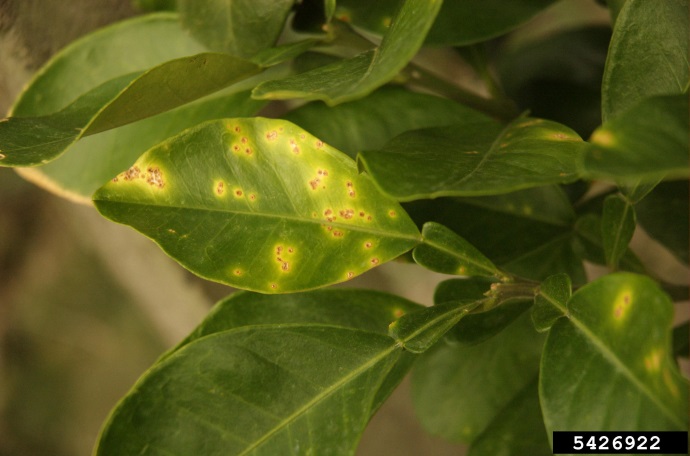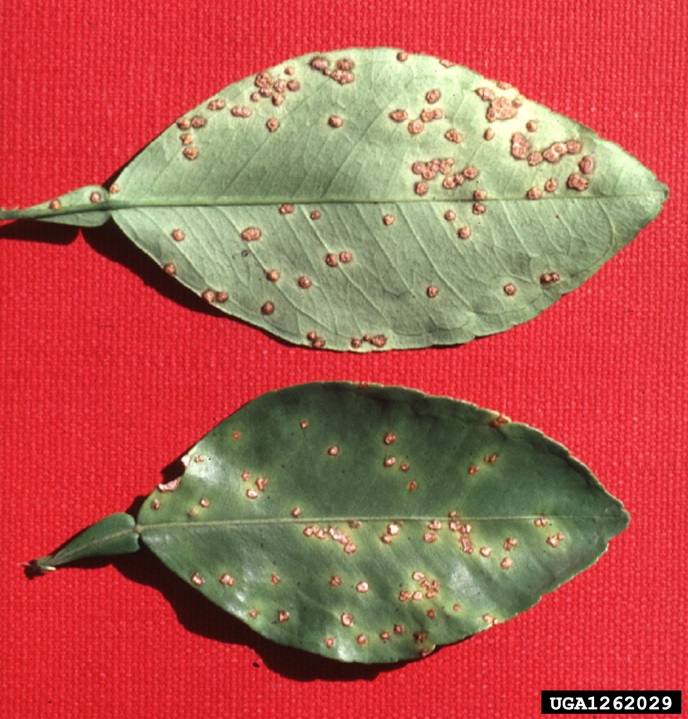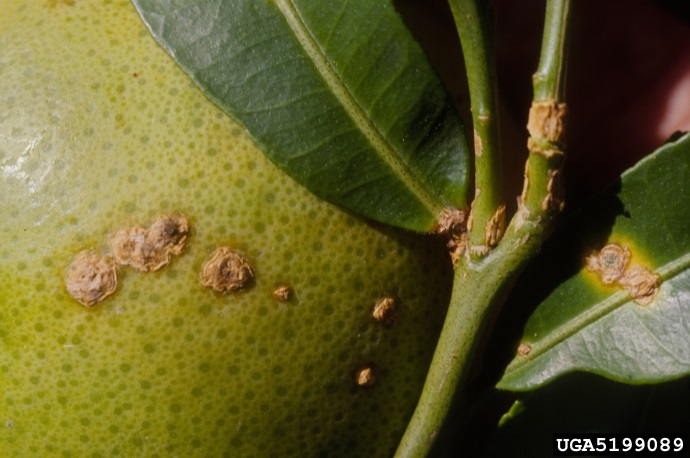
Citrus canker
| Primefact number | Edition | Published | Author |
|---|---|---|---|
| 1183 | Second | Apr 2017 | Plant Biosecurity and Product Integrity |



Citrus canker (Xanthomonas citri subsp. citri) is an exotic plant pest not present in NSW. This disease is a serious threat to Australia’s citrus industry.
Notifiable status
Citrus canker (Xanthomonas citri subsp. citri) is a notifiable plant disease in NSW.
All notifiable plant pests and diseases must be reported within 1 working day. You can report notifiable plant pests and diseases by one of the following methods:
- Call the Exotic Plant Pest Hotline 1800 084 881
- Email biosecurity@dpi.nsw.gov.au with a clear photo and your contact details
- Complete an online form
A full list of notifiable plant pests and diseases can be found in Schedule 2 of the NSW Biosecurity Act 2015.
Description
Citrus canker is a highly contagious bacterial disease caused by Xanthomonas citri subsp. citri (former name Xanthomonas axonopodis pv. citri).
All above-ground parts of citrus trees can be affected. Severe infection can lead to defoliation, dieback, blemished fruit and premature fruit drop.
Citrus canker is a plant disease and is not harmful to people or animals.
Symptoms
Leaves
Symptoms first appear on the leaves (Figure 1). Small yellow marks the size of a pinhead develop into pimply, watery dots. These can then develop into scabby lesions or cankers.
Young lesions project above the leaf surface on both sides but are more apparent on the underside (Figure 2).
As lesions age and thicken they change colour from white to tan. They become corky and may develop a crater-like depression in the centre. Lesions often have a water soaked margin and are surrounded by a yellow halo.
Citrus canker lesions often occur in groups where water pools on the leaf or follow the feeding tracks of citrus leaf miners.
In wet conditions lesions rapidly enlarge and flatten out and have a water-soaked appearance. Under dry conditions lesions remain corky in appearance.
Infection can lead to early leaf fall.
Branches
Cankers can occur on woody stems as the infection spreads from the leaves to twigs and branches.
Bark may discolour and underlying tissues appear red when cut. Stems could die back.
Fruit
Ripening fruit on infected trees may develop scabs or pitting. Lesions initially resemble large oil glands on the rind then gradually darken and become corky in texture.
Lesions on fruit are usually round and can occur singularly or in groups. The scabby appearance makes affected fruit unmarketable.
Fruit may drop prematurely.
Multiple lesions on fruit or stems are typically only seen in cases where the foliage is severely infected (Figure 3).
Hosts
Citrus canker affects plants in the Rutaceae family, including those from the genera Citrus, Fortunella and Poncirus.
All commercial citrus cultivars can be affected.
Native Australian Rutaceae species such as desert lime (Citrus glauca), lemon aspen (Acronychia acidula), lime berry (Micromelum minutum) and native mock orange (Murraya paniculata var. ovatifoliolata) are potential hosts of citrus canker.
Lifecycle
New outbreaks of citrus canker usually occur when new shoots are emerging or when fruit is at an early stage of development. Bacteria enter actively growing shoots and leaves through natural openings (such as stomata and flower openings) and wounds (either mechanical or insect wounds).
The first 90 days after petal fall are the most critical for fruit infection. Susceptibility to infection declines as plant growth matures.
Latent infections can occur on shoots infected in autumn.
Survival
Citrus canker bacteria may survive for up to 10 months in lesions on living citrus plants. Survival for long periods is possible in diseased plant tissues including the discoloured bark on citrus tree trunks and limbs and in plant debris.
In areas where citrus canker is established the bacteria are able to persist in a non pathogenic form as an epiphyte on host and non-host plants and as a weak saprophyte on mulch or in soil. These bacteria provide a reservoir for subsequent symptom development on susceptible hosts.
Spread and movement
Dormant lesions become active with spring rains.
Movement of citrus canker bacteria within the canopy of an infected tree is aided by free moisture. Wind-driven rain and water splash are the primary means of short distance spread within and between trees. Overhead and spray irrigation can increase the rate of disease spread within an infected orchard.
Contaminated tools and equipment, orchard workers, birds and insects could spread citrus canker in an infected orchard.
Long distance spread occurs through the movement of infected plants or plant parts including nursery trees and propagation material (budwood, rootstock seedlings and budded trees).
Cyclones and severe weather events of strong winds and rain can spread citrus canker long distances.
Distribution
Citrus canker probably originated in South-East Asia. It is now widespread in many tropical and subtropical citrus growing areas of the world.
Australia has experienced a number of citrus canker outbreaks. All have been eradicated.
Australia is currently free from citrus canker.
Actions to minimise risks
Put in place biosecurity best practice actions to prevent entry, establishment and spread of pests and disease:
- practice “Come clean, Go clean”
- ensure all staff and visitors are instructed in and adhere to your business management hygiene requirements
- source propagation material of a known high health status from reputable suppliers
- keep records

